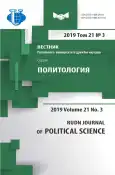Militia Participation in Counterinsurgency: The Impetus of Civilian Joint Task Participation in Combating Boko Haram in Nigeria
- 作者: Gana M.L.1
-
隶属关系:
- Mai Idriss Alooma Polytechnic Geidam
- 期: 卷 21, 编号 3 (2019)
- 页面: 460-469
- 栏目: POLITICAL PROCESSES IN CONTEMPORARY WORLD
- URL: https://journal-vniispk.ru/2313-1438/article/view/339715
- DOI: https://doi.org/10.22363/2313-1438-2019-21-3-460-469
- ID: 339715
如何引用文章
全文:
详细
Since 2013, the north of Nigeria has witnessed an increased involvement of the militia group ‘Civilian Joint Task Force’ (CJTF) in combating the Islamist insurgent group Boko Haram. The mobilization of the Civilian Joint Task Force brought a tremendous success to the counterinsurgency operation. Before the CJTF’s engagement, the antiterrorism efforts of the government were marred by negligent performance. In addition to helping decrease the attack frequencies and number of fatalities caused by the insurgent group, the militia succeeded in expelling Boko Haram fighters from the towns and villages they had previously occupied. However, the unprecedented participation of the Civilian Joint Task Force in the counterinsurgency campaign has raised certain suspicions of the public in regards to the CJTF’s ulterior motives. This paper, therefore, explores the motives that triggered people’s participation in the Civilian Joint Task Force with the aim to combat the Boko Haram insurgent group. The current paper is a qualitative research, designed as a case study. The empirical data were collected by means of an in-depth interview involving 13 respondents, among who were the members of the CJTF, community leaders and government officials in Yobe State, Nigeria. The findings show that people’s participation in the CJTF is voluntary, with the main motivation being the necessity to defend the community due to the state’s failure to provide adequate protection. The article points out an urgent need to demobilize and deradicalize the participants in order to prevent the CJTF from further jeopardizing local communities’ peace and stability.
作者简介
Modu Gana
Mai Idriss Alooma Polytechnic Geidam
编辑信件的主要联系方式.
Email: gana.lawan@yahoo.com
PhD in Political Science, Lecturer
1023 Gashua Road Geidam, Yobe State, Nigeria参考
- Agbiboa D. Resistance to Boko Haram: Civilian Joint Task Forces in North-Eastern Nigeria Conflict Studies Quarterly. Conflict Studies Quarterly. 2015: 3—22.
- Bamidele O. Civilian Joint Task Force’ (CJTF) — A Community Security Option: A Comprehensive and Proactive Strategy to Counter-Terrorism. Journal for Deradicalization. 2016; Vol. 7: 124—144.
- Salaam A.O. Boko Haram: Beyond Religious Fanaticism. Journal of Policing, Intelligence and Counter Terrorism. 2012; Vol. 7; 2: 147—162.
- Aghedo I., Osumah. O. The Boko Haram Uprising: How Should Nigeria Respond? Third World Quarterly. 2012; Vol. 33 (5): 853—869.
- Pham J-P. Boko Haram’s Evolving Threat. Africa Security Brief: A Publication of the Africa Center for Strategic Studies. 2012; 20: 1—7.
- Shola O.J. Globalization of Terrorism: A Case Study of Boko-Haram in Nigeria. International Journal of Politics and Good Governance. 2015; Vol. 6.1: 1—22.
- Muhammad A., Baba I.M. Resolving Nigeria’s “Boko Haram” Insurgence: What Role for the Media? Procedia — Social and Behavioural Sciences. 2014: 155.
- Falode J.A. The Nature of Nigeria’s Boko Haram War, 2010—2015: A Strategic Analysis. Perspectives on Terrorism. 2016; Vol. 10.1: 41—52.
- Oyewole S. Boko Haram and the Challenges of Nigeria’s War on Terror. Defence & Security Analysis. 2013; Vol. 29 (3): 253—262.
- Bappah H.Y. Nigeria’s Military Failure Against the Boko Haram Insurgency. African Security Review. 2016; Vol. 25; 2: 146—158.
- Gana M.L., Samsu K.H., Ismail M.M. Population-Centric Counterinsurgency: The Conduit for Ending Boko Haram Insurgency in Nigeria’s North. European Journal of Behavioral Sciences. 2018; 1 (4): 8—13.
- Gana M.L., Samsu K.H., Ismail M.M. Counterinsurgency Responses in Nigeria: Unveiling the Constraining Challenges. International Journal of Arts, Humanities and Social Sciences. 2018. Vol. 3.6: 1—8.
- Fahim S. The Role of Militias in Counterinsurgency Doctrine: The Fall of Kunduz and Mosul. Master’s Thesis submitted to Department of International Studies, Indiana University; 2018.
- Hassan I., Pieri Z. The Rise and Risks of Nigeria’s Civilian Joint Task Force: Implications for Post-Conflict Recovery in Northeastern Nigeria. Boko Haram beyond the Headlines: Analyses of Africa’s Enduring Insurgency. Jacob Zenn Eds. Combating Terrorism Center; 2018.
- Fearon J.D., Laitin D.D. Ethnicity, Insurgency, and Civil War. American Political Science Review. 2003; Vol. 97.1: 75—90.
- Stringham N., Forney J. It Takes a Village to Raise a Militia: Local Politics, The Nuer White Army, and South Sudan’s Civil Wars. Journal of Modern African Studies. 2017; Vol. 55.2: 177—199.
- Jones S.G. The Strategic Logic of Militia. National Defence Research Institute Working Paper, WR-913-SOCOM. 2012.
- Olanrewaju F.O., Folarin O.M., Folarin S.F. Insurgency and National Security Challenges in Nigeria: An Introductory Analysis. Ante Portas — Studia nad Bezpieczeństwem. 2017; Vol. 2.9: 35—53.
- Schubert M. The Challenge of Community-Based Armed Groups: Towards a Conceptualization of Militias, Gangs, and Vigilantes. Contemporary Security Policy. 2015; Vol. 36.2: 296—320.
补充文件









